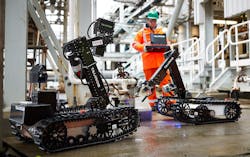Equinor enters offshore robotics consortium
Offshore staff
ABERDEEN, UK – Equinor and Saft have joined Total and the Oil and Gas Technology Centre (OGTC) in the next-phase of an offshore robotics project, developed by Taurob.
The OGRIP (Offshore Ground Robotics Industrial Pilot) robot was first shown publicly last month at SPE Offshore Europe 2019 in Aberdeen.
Under the next phase Taurob will develop what is claimed to be the world’s first offshore work class robot (OWCR).
This will be designed mainly for use as a surveillance vehicle, but with an improved chassis, compared to the OGRIP, and with active manipulation, to complement surveying, inspection, and observation.
Jean-Michel Munoz, R&D Next Generation Facilities Project Manager – Deep Offshore Program from Total E&P, said: “Exploration and production operations are conducted in increasingly harsh and challenging conditions, including extreme cold, arid climates and isolated locations.
“This project is key to Total’s forward-thinking approach, making operations safer by reducing the exposure of personnel to potentially high-risk situations and the immense challenges our teams face – paving the way for tomorrow’s simpler, streamlined and less expensive facilities that will require less annual maintenance.
“Routine inspection tasks will be automated and performed by the robot, leaving the operator free to concentrate on complex tasks that robots are yet able to perform.”
Stine Vatneberg, Leader of Automation Technology for R&D at Equinor, said: “Equinor recently awarded the first contract on use of wireless, autonomous underwater drones in the oil and gas industry…
“Maximizing the robot’s operational time in an ATEX environment requires a high capacity battery with the ability to fast charge. The project scope will break new ground by introducing a fully ATEX-certified lithium-ion battery, increasing operational usefulness, extend performance and will unlock many new applications.”
Paul Gallot-Lavallée, General Manager of Saft France, Space & Defense Division commented: “With the requirement to grant the robot autonomy and time to operate in the most severe conditions, Saft is developing the first ATEX/IECEx lithium-ion battery in the energy range 500 to 1,000 Wh.
“We use individual Saft MP176065 ise cells (made in Poitiers, France) that can operate in severe environmental conditions, including a wide temperature range from -30°C to +60°C (-22°F to +140°F).
“Our cells are arranged in a modular architecture that allows the robot manufacturer to adapt the sizing to the stringent needs of oil and gas platforms. Moreover, the largely improved charging rate and cycling lifetime compared to traditional batteries will allow for a continuous and smooth operation of the robot; the battery will be maintenance free for a full year.”
Matthias Biegl, Managing Director for Taurob, added: “These robots will perform countless missions and duration tests on different sites, and we will increase their capabilities to work on unmanned installations within the recently started joint industry project.
“Together with Total E&P, Equinor, Saft and the OGTC, we will completely re-design robots to fulfill the needs of solo missions and a high level of complexity regarding manipulation and safety. In parallel, we have started to set up an integrated robotics production and support service to facilitate worldwide rollout of robots together with our partner, Dietsmann.”
10/21/2019
